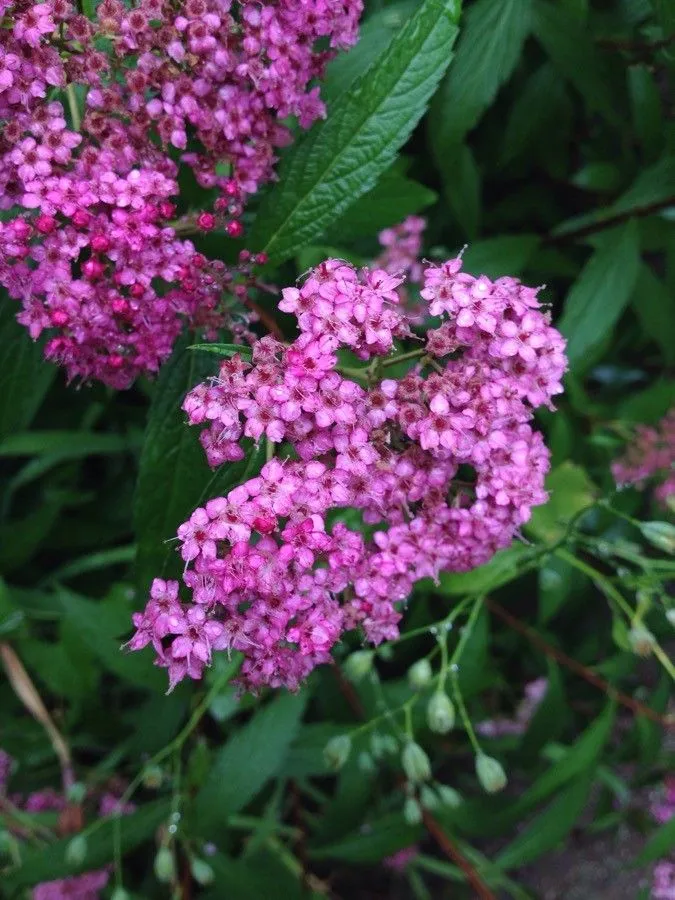
Author: L.f.
Bibliography: Suppl. Pl.: 262 (1782)
Year: 1782
Status: accepted
Rank: species
Genus: Spiraea
Vegetable: Unknown
Observations: China to N. Myanmar, C. & S. Japan, Taiwan
Japanese Spiraea: An Ornamental Gem
Japanese spiraea, known scientifically as Spiraea japonica, is a cherished plant within the Rosaceae family. Its original description dates back to 1782 when it was meticulously cataloged by the Swedish botanist Carl Linnaeus the Younger in his publication, “Suppl. Pl.”
Natural Habitat and Distribution
This elegant shrub finds its roots across various regions of East Asia, stretching from the temperate zones of central and southern Japan to the diverse landscapes of Taiwan, and even extending into China and northern Myanmar. Such widespread distribution showcases the plant’s adaptability to different climatic conditions.
Botanical Characteristics
Japanese spiraea is renowned for its hardiness and vibrant late spring to early summer blossoms. It typically manifests as a deciduous shrub that can reach heights of 1 to 2 meters. The leaves are small, ovate, and serrated, creating a lush green backdrop for its standout feature: the flowers.
Spectacular Blooms
The flowers of the Japanese spiraea are a sight to behold. They form dense clusters of tiny, star-shaped blossoms that range in color from soft pink to rosy red, creating a stunning visual effect. This profusion of blooms not only adds a splash of color to gardens but also attracts a myriad of pollinators, including bees and butterflies.
Cultivation and Uses
Due to its robust nature and attractive appearance, Japanese spiraea has become a popular choice for ornamental gardening. It thrives in full sun to partial shade and prefers well-drained soil. Gardeners appreciate its resilience and low maintenance requirements, making it ideal for borders, hedges, and mass plantings.
Moreover, this plant has gained favor as a landscaping tool due to its aesthetic appeal and ability to provide seasonal interest throughout much of the year. After its flowering period, the foliage often takes on a captivating autumnal hue, further extending its visual interest.
Ecological Impact
Though visually appealing, care must be taken when cultivating Japanese spiraea, as it has the potential to become invasive outside its native range. Proper management and monitoring can mitigate this risk, ensuring that this beautiful plant enhances garden spaces without disrupting local ecosystems.
Conclusion
Japanese spiraea, or Spiraea japonica, remains a cornerstone of ornamental horticulture with its dazzling displays of blooms and robust nature. Originating from diverse regions across East Asia, this plant has successfully captured the hearts of gardeners worldwide. Its beauty, coupled with ease of care, cements its status as a beloved addition to any garden seeking a burst of color and charm.
Eng: japanese meadowsweet, japanese spiraea, fortune meadowsweet
Deu: japanischer spierstrauch
Dan: rosen-spiræa
Fra: spirée du japon
Hun: japán bajnóca
Swe: praktspirea, höstspirea, rosenspirea
Nld: japanse spirea
Cym: erwain japan
En: Japanese Spiraea, Japanese meadowsweet, Fortune meadowsweet
Da: Rosen-spiræa
Nl: Japanse spirea
Fr: Spirée du Japon
De: Japanischer Spierstrauch, Japan-Spierstrauch
Hu: Japán bajnóca
It: Spirea del Giappone
Sv: Praktspirea, Höstspirea, Rosenspirea
Cy: Erwain Japan
Taken Jul 12, 2019 by Alex Collins (cc-by-sa)
Taken Sep 29, 2018 by Dieter Wagner (cc-by-sa)
Taken Jun 24, 2019 by Dieter Wagner (cc-by-sa)
Taken Jun 24, 2019 by Dieter Wagner (cc-by-sa)
Taken Jun 24, 2019 by Dieter Wagner (cc-by-sa)
Taken Nov 15, 2020 by grutz (cc-by-sa)
Taken Jun 9, 2021 by Manuëlle (cc-by-sa)
Taken Oct 24, 2022 by Fabrice Rubio (cc-by-sa)
Taken Dec 12, 2019 by Dieter Wagner (cc-by-sa)
Taken Jun 24, 2019 by Dieter Wagner (cc-by-sa)
Taken May 26, 2022 by Kai Best (cc-by-sa)
Taken Aug 29, 2021 by Darren Giddins (cc-by-sa)
Taken Jun 27, 2018 by Dieter Wagner (cc-by-sa)
Taken Jun 9, 2021 by Manuëlle (cc-by-sa)
Taken Oct 24, 2022 by Fabrice Rubio (cc-by-sa)
Taken Jun 20, 2020 by Giode Tonpino (cc-by-sa)
Taken May 8, 2022 by Tristan Jaton-Maria (cc-by-sa)
Taken Jun 20, 2020 by Giode Tonpino (cc-by-sa)
Taken Jun 4, 2019 by Valeriy (cc-by-sa)
Taken Oct 31, 2022 by Jim Knopf (cc-by-sa)
Taken Sep 9, 2021 by Fabrice Rubio (cc-by-sa)
Taken Jun 14, 2022 by Boudewijn Swart (cc-by-sa)
Taken Jul 3, 2022 by Sheri-Ann Kelly (cc-by-sa)
Taken May 31, 2020 by Laurent Lag (cc-by-sa)
Taken Nov 24, 2020 by Lucio. ciaffi (cc-by-sa)
Taken Oct 19, 2022 by Klister (cc-by-sa)
Taken May 28, 2022 by Andrea Herczeg (cc-by-sa)
Taken Jul 15, 2020 by gabriella (cc-by-sa)
Taken Jul 21, 2022 by Oğuzhan (cc-by-sa)
Taken Jul 25, 2022 by Oğuzhan (cc-by-sa)
© copyright of the Board of Trustees of the Royal Botanic Gardens, Kew.
© copyright of the Board of Trustees of the Royal Botanic Gardens, Kew.
© copyright of the Board of Trustees of the Royal Botanic Gardens, Kew.
Family: Myrtaceae Author: (F.Muell.) K.D.Hill & L.A.S.Johnson Bibliography: Telopea 6: 402 (1995) Year: 1995 Status:…
Family: Rubiaceae Author: Pierre ex A.Froehner Bibliography: Notizbl. Bot. Gart. Berlin-Dahlem 1: 237 (1897) Year:…
Family: Sapindaceae Author: Koidz. Bibliography: J. Coll. Sci. Imp. Univ. Tokyo 32(1): 38 (1911) Year:…
Family: Asteraceae Author: A.Gray Bibliography: Pacif. Railr. Rep.: 107 (1857) Year: 1857 Status: accepted Rank:…
Family: Fabaceae Author: Medik. Bibliography: Vorles. Churpfälz. Phys.-Ökon. Ges. 2: 398 (1787) Year: 1787 Status:…
Family: Aspleniaceae Author: (Cav.) Alston Bibliography: Bull. Misc. Inform. Kew 1932: 309 (1932) Year: 1932…